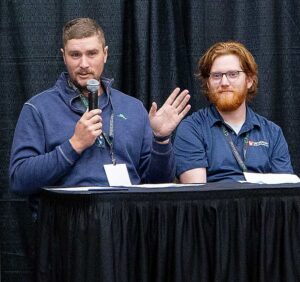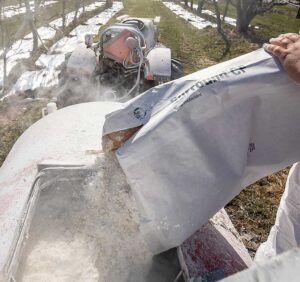—by Kate Prengaman

To test how well pear psylla IPM is working for growers in the Wenatchee River Valley area, Washington State University entomologists set up a series of paired orchards to compare pest levels in conventional orchards to those using integrated pest management strategies.
The problem is that growers, pleased with the IPM performance, keep transitioning their conventional blocks to the new approach.
That’s certainly the case for Matt McDevitt, who lent his Peshastin-area orchard to WSU researchers hosting a field day on July 24 to discuss all things IPM.
“I had three spray programs going on, and my fieldman thought the conventional was working the least,” McDevitt said by way of introduction to field day attendees.
The challenge conventional pear growers face is that pear psylla populations tend to blow up in the third generation, leading to sticky fruit and high populations overwintering. The IPM approach uses selective sprays to encourage biocontrol, said WSU entomologist Robert Orpet.
“The challenge is that it takes time for biocontrol to build, and you need to have prey to build up predators,” he said. But if growers can minimize the impact from psylla earlier in the season, the IPM approach seems to allow growers to spray less.
That’s been the case for McDevitt, he said. In his first year with the IPM program, his pears were pretty sticky, but last season went well, he said, and this year the pressure has stayed low enough that he had not sprayed for psylla since petal fall. That’s a nice cost savings to have in a record-low crop year.

Other growers in the valley report seeing higher levels of psylla pressure this year compared to last year, said Molly Sayles, a doctoral student in Orpet’s lab.
“Every year we have different weather,” she said of the research project to evaluate IPM practices, which has now spanned three growing seasons at seven pairs of sites. To continue to evaluate McDevitt’s site, they had to enlist a neighbor’s conventional block.
At the field day, she and her fellow entomology students showed attendees how to use beat traps to sample orchards for pear psylla and its enemies.
As more growers across the region adopt IPM practices to protect natural enemies, proponents hope the benefits will grow for everyone.
“The more people that get involved, that makes me happy because it gives us all a better chance,” said grower Mel Weythman, who adopted the IPM approach several years ago. But he also offered a note of caution: “You have to be willing to put up with some hurt; there’s a definite lag phase.” •








Leave A Comment